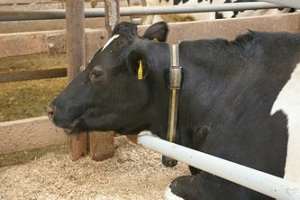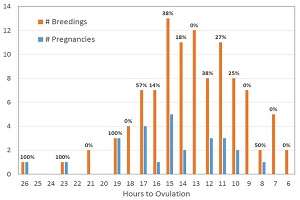An example of how one farmer is using data from an activity monitoring system to identify the optimum breeding time for his farm.

While timing of insemination is not the only factor required to achieve a successful breeding in dairy cattle, if the sperm does not reach the unfertilized egg at the appropriate time the cow will not become pregnant. Activity monitoring systems are one tool that can help a dairy producer identify cows in heat and the appropriate breeding time. This article will discuss how a dairy farmer is using data from an activity monitoring system to identify the optimum breeding time for his farm.
A commercially available activity system (SCR Heatime System) was used to monitor cow activity and identify the optimum time to artificially inseminate lactating dairy cows. The system continuously monitors the activity level of each cow in the herd fitted with an activity tag. When a cow is in heat her activity level will increase. The system identifies the time of peak activity and then begins counting down the hours to zero; the system defines this as ‘Hours to Ovulation’. At breeding the dairy farmer recorded the date, cow ID, and hours to ovulation reported by the activity system. A total of 104 breedings were recorded. The figure below shows the distribution of breedings by hours to ovulation (larger numbers are closer to peak activity) and the number and percentage of breedings that resulted in pregnancies.

Distribution of breedings (orange bars) for each hour hour following peak activity (larger "hours to ovulation" is closer to the time of peak activity), and the number of pregnancies resulting from these breedings (blue bars). The percentage of pregnancies is shown above each pair of bars.
Of the 104 breedings recorded, 26 resulted in a pregnancy, for a 25% conception rate for these breedings. At 9 or less hours there were 16 breedings (15% of all breedings), but only one of these resulted in a pregnancy. For this farm, breeding cows at 9 or less hours should be avoided. At over 20 hours there were 4 breedings. Fifty percent (50%) of these breedings resulted in a pregnancy, however, the limited data makes it difficult to make strong recommendations for this time period. At 17 hours there were a total of 7 breedings, with 57% of these resulting in a pregnancy. Good results were also achieved at 12 and 15 hours, with 38% of breedings at these times resulting in a pregnancy. Thirteen hours is an anomaly; while there were 12 breedings in this time, none of them resulted in a pregnancy. Why 13 hours was that much different from 12 or 14 hours is not clear.